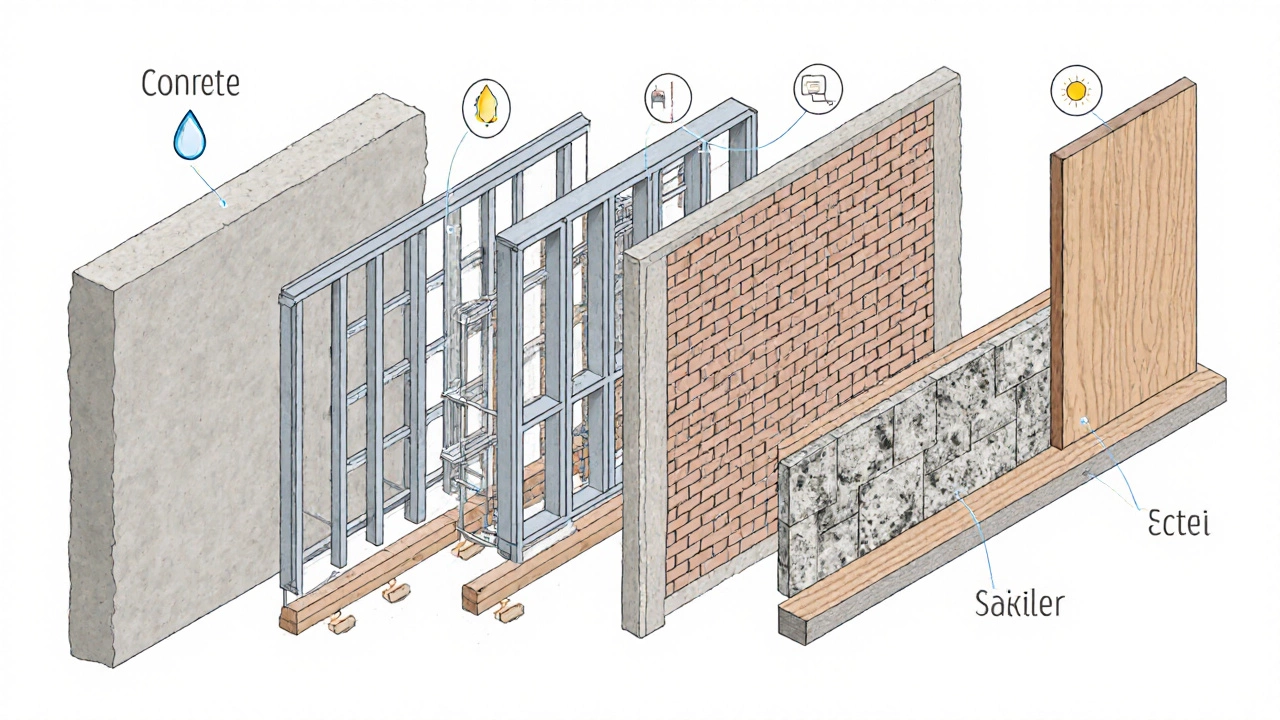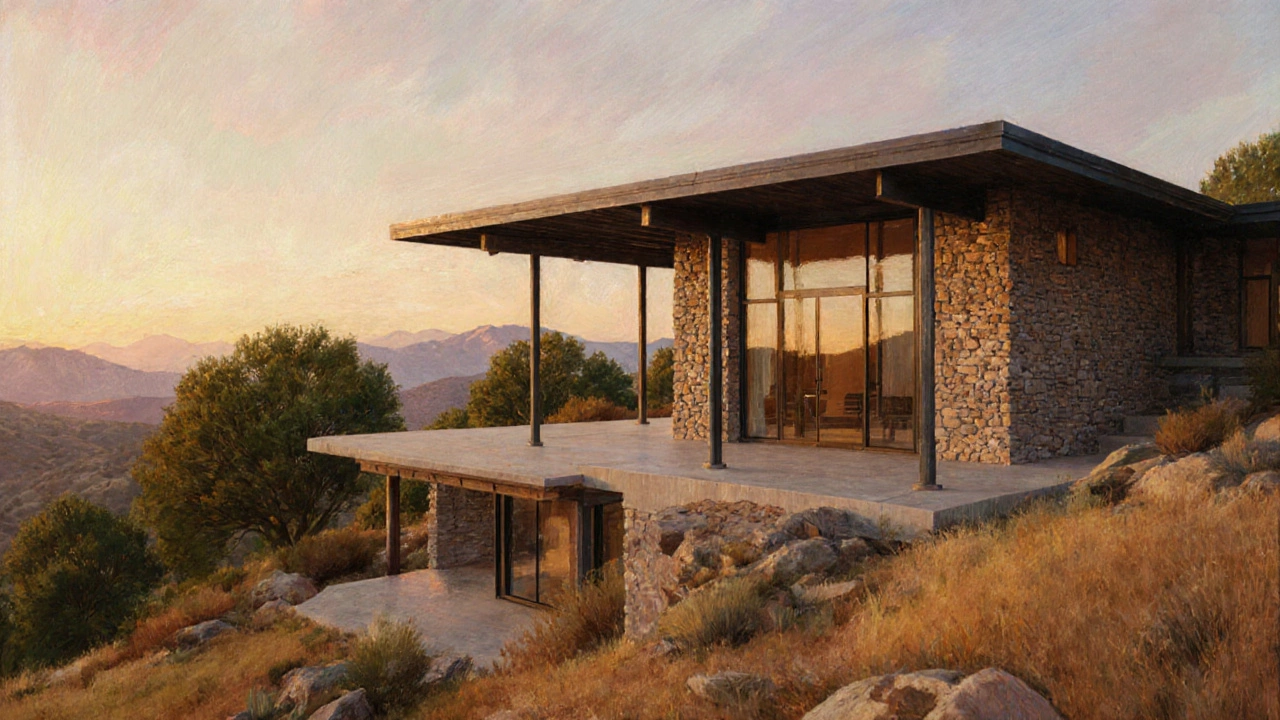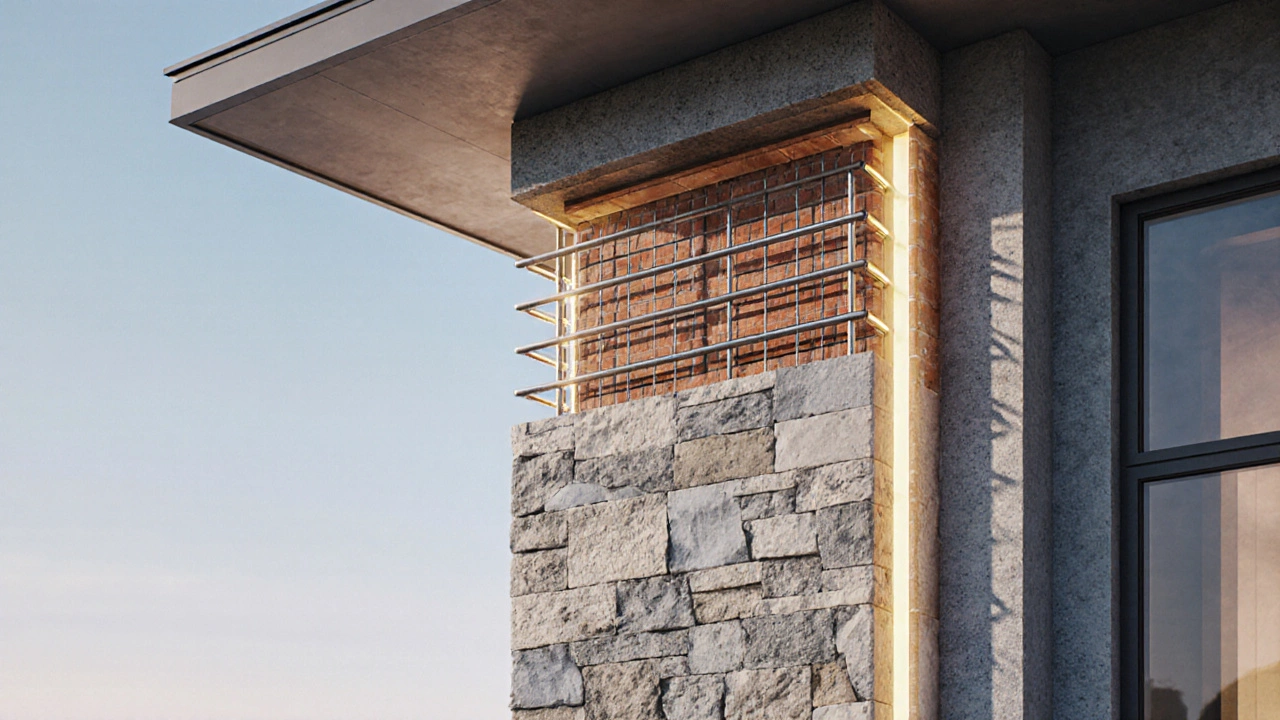Building Material Longevity Calculator
Find Your Ideal Building Material
Answer these questions to see which materials best match your project requirements
When you start planning a new home, the biggest question often isn’t about style or size-it’s about how long the walls will stand. Choosing a long lasting building material can mean the difference between a house that needs major repairs in 30 years and one that endures for a century or more.
What Determines a Material’s Lifespan?
Durability isn’t a single number; it’s the result of several factors:
- Intrinsic strength: how well the material resists compression, tension, and environmental stress.
- Resistance to moisture: water is the number‑one enemy for most building components.
- UV and temperature stability: extreme heat or cold cycles can cause cracking.
- Maintenance requirements: some materials need regular sealing or treatment to stay strong.
- Local climate: a material that thrives in a dry desert may falter in a humid coastal zone.
By weighing these variables, you can narrow down the list of candidates that truly qualify as "long‑lasting".
Concrete - The Workhorse of Modern Construction
When it comes to durability, Concrete is a composite material made of cement, aggregates, and water that hardens into a stone‑like mass. Its typical lifespan can exceed 100years with proper mix design and protection. Modern high‑performance mixes incorporate corrosion‑resistant rebar and low‑shrink additives, which keep cracking at bay. In flood‑prone regions, adding waterproofing admixtures can push service life well past a century. Concrete’s biggest drawback is its carbon footprint, but for longevity it’s hard to beat.
Steel - The Strong, Flexible Option
Steel is an alloy of iron and carbon that offers impressive tensile strength and flexibility. When properly coated-galvanized, weather‑proofed, or painted-steel frames can last 80‑120years. Its ability to absorb seismic forces makes it popular in earthquake zones. The main maintenance task is protecting against rust, especially in coastal or high‑humidity areas.
Brick and Stone - Classic, Low‑Maintenance Choices
Brick is a fired clay unit that, when laid with proper mortar, can survive 100‑120years. Its thermal mass helps regulate indoor temperature, reducing heating and cooling costs. Likewise, Stone-whether granite, limestone, or sandstone-offers natural durability, often lasting several centuries with little upkeep. Both materials resist fire and moisture, though poor mortar or improper flashing can cause water intrusion over time.

Engineered Wood - Modern Performance from a Traditional Material
Engineered wood (e.g., I‑joists, laminated veneer lumber) combines wood strands with adhesives to create components that outperform solid timber in strength and stability. When kept dry and sealed, engineered wood can reliably last 40‑60years in residential framing. Regular inspection of joints and protective coatings extends that window.
Bamboo - Sustainable Yet Strong
Bamboo is a fast‑growing grass that, once treated, becomes a surprisingly hard building material. Properly carbon‑treated bamboo can last 30‑50years in a house structure, especially in tropical climates where its natural flexibility helps combat humidity. Its renewability makes it attractive, but it still requires periodic sealing against pests and rot.
Adobe and Rammed Earth - Earth‑Bound Longevity
Adobe consists of sun‑dried mud bricks mixed with straw. When protected with wide eaves and plaster, adobe walls can survive 100years or more, as seen in historic missions across the American Southwest.
Rammed earth is a technique that compacts a mixture of soil, sand, and stabilizer into forms, creating dense walls that often exceed 150years in service life. Both methods excel in dry climates but demand careful moisture management in wetter areas.
Comparison of Long‑Lasting Materials
| Material | Typical Lifespan | Maintenance | Relative Cost | Best Climate |
|---|---|---|---|---|
| Concrete | 100+years | Seal cracks, occasional waterproofing | Medium‑High | All, especially humid |
| Steel | 80‑120years | Corrosion‑protective coating | High | Seismic zones, coastal |
| Brick | 100‑120years | Mortar repointing | Medium | Temperate |
| Stone | 200+years | Rare, occasional cleaning | High | All, especially dry |
| Engineered Wood | 40‑60years | Seal joints, avoid moisture | Medium | Temperate |
| Bamboo | 30‑50years | Carbon treatment, seal | Low‑Medium | Tropical, subtropical |
| Adobe | 100+years | Plaster, roof overhangs | Low‑Medium | Arid |
| Rammed Earth | 150+years | Protective render | Medium‑High | Dry to moderate |

How to Pick the Right Material for Your Project
Even the toughest material can fail if it’s mismatched to the site. Follow these steps:
- Assess climate: High humidity points toward concrete or protected stone; extreme heat favors adobe or rammed earth.
- Consider budget: Bamboo and adobe are inexpensive, while steel and natural stone raise the price.
- Look at structural needs: For large open spans, steel’s tensile strength shines. For thick load‑bearing walls, masonry (brick/stone) works well.
- Plan for maintenance: If you prefer a set‑and‑forget wall, stone or concrete are low‑maintenance. If you enjoy periodic upkeep, engineered wood can be a rewarding choice.
- Check local codes: Some municipalities have restrictions on earthen walls or require fire‑rated assemblies.
By aligning material attributes with these criteria, you’ll pick the option that truly lasts.
Maintenance Tips to Extend Material Life
- Seal joints and surfaces every 5‑10years for concrete and masonry.
- Inspect coatings on steel annually and re‑apply protective paint before rust appears.
- Keep water away: Proper flashing, gutters, and grading protect all materials, especially wood and earthen walls.
- Control indoor humidity with ventilation or dehumidifiers to prevent rot in wood‑based systems.
- Repair cracks early using compatible patching compounds to avoid water infiltration.
Common Pitfalls and How to Avoid Them
Even seasoned builders slip up:
- Over‑specifying strength: Using ultra‑high‑strength concrete where regular mixes suffice adds cost without lifespan gain.
- Neglecting moisture barriers: Forgetting a vapor barrier under slab can cause concrete rebar corrosion.
- Choosing the wrong finish: Applying a breathable plaster over stone can trap moisture and cause spalling.
- Ignoring local experience: Importing rammed‑earth techniques to a wet climate without proper stabilization leads to erosion.
Plan ahead, consult local experts, and stick to proven detailing.
Frequently Asked Questions
Which material truly lasts the longest?
Natural stone-especially granite or basalt-can exceed 200years with minimal upkeep, making it the longest‑lasting option for residential walls.
Is concrete always the best choice for durability?
Concrete is extremely durable, but its performance hinges on mix design, proper curing, and protection from moisture. In corrosive soils or aggressive environments, additional additives or protective coatings are essential.
Can I combine materials to get the best of both worlds?
Yes. A common strategy is a steel frame for structural flexibility, with concrete floors and brick or stone infill walls. This hybrid approach maximizes strength, fire resistance, and lifespan.
How does climate affect material choice?
In humid coastal areas, water‑resistant concrete and coated steel perform best. In arid deserts, adobe or rammed earth thrive due to low moisture exposure. Always match material to local weather patterns.
What is the maintenance frequency for steel structures?
Inspect for rust or coating degradation at least once a year. Re‑paint or re‑galvanize any exposed sections every 5‑10years, depending on the environment.
Bottom Line
If you want a wall that could stand for centuries, natural stone tops the list, followed closely by high‑grade concrete and well‑protected steel. For most homeowners balancing cost, aesthetics, and upkeep, a mix of concrete foundations, steel framing, and brick or stone veneer delivers a durable, low‑maintenance home that outlives trends.

Author
Damon Blackwood
I'm a seasoned consultant in the services industry, focusing primarily on project management and operational efficiency. I have a passion for writing about construction trends, exploring innovative techniques, and the impact of technology on traditional building practices. My work involves collaborating with construction firms to optimize their operations, ensuring they meet the industry's evolving demands. Through my writing, I aim to educate and inspire professionals in the construction field, sharing valuable insights and practical advice to enhance their projects.